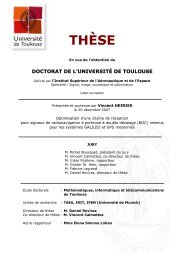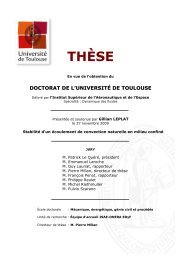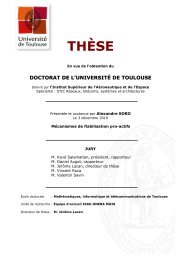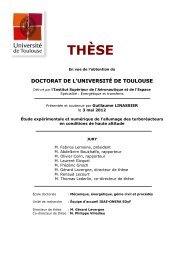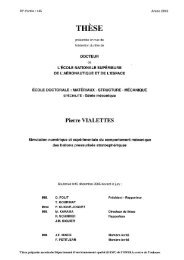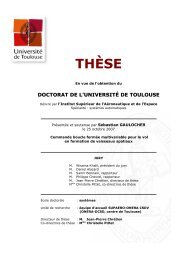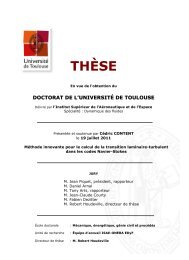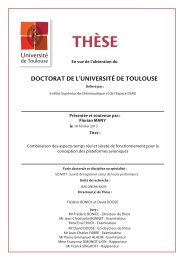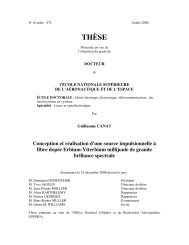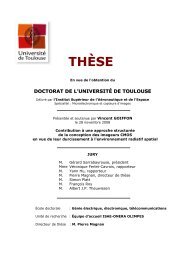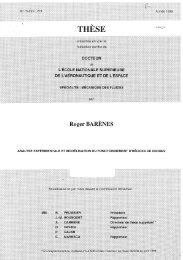Modélisation et simulation numérique de la génération de plasma ...
Modélisation et simulation numérique de la génération de plasma ...
Modélisation et simulation numérique de la génération de plasma ...
Create successful ePaper yourself
Turn your PDF publications into a flip-book with our unique Google optimized e-Paper software.
TABLE DES FIGURES3.6 Eff<strong>et</strong> <strong>de</strong> <strong>la</strong> ’DC1’ (gauche) <strong>et</strong> <strong>la</strong> ’DC2’ (droite) sur une couche limite <strong>la</strong>minaire ([62]) 394.1 Un exemple <strong>de</strong> l’eff<strong>et</strong> d’un écoulement sur les décharges : stabilisation <strong>de</strong> couronnespointe-p<strong>la</strong>n [50] . . . . . . . . . . . . . . . . . . . . . . . . . . . . . . . . . . . . 424.2 Coup<strong>la</strong>ge Aérodynamique - Décharge/P<strong>la</strong>sma . . . . . . . . . . . . . . . . . . . . 424.3 Principaux phénomènes <strong>de</strong> l’interaction couronnes aérodynamique . . . . . . . . 434.4 Champ électrique créé par le dispositif pour V G = 32 kV (en rouge, le champ <strong>de</strong>c<strong>la</strong>quage ≃ 30 kV/cm) . . . . . . . . . . . . . . . . . . . . . . . . . . . . . . . . . 444.5 Principe du modèle phénoménologique . . . . . . . . . . . . . . . . . . . . . . . . 454.6 Schéma représentatif du calcul aérodynamique avec le modèle phénoménologique 464.7 Composantes tangentielle (gauche) <strong>et</strong> perpendicu<strong>la</strong>ire à <strong>la</strong> paroi (droite) du ventionique obtenu par le modèle phénoménologique . . . . . . . . . . . . . . . . . . . 474.8 Profils <strong>de</strong> vitesse du vent ionique obtenu par le modèle phénoménologique (—) <strong>et</strong>par les mesures [62] (o) . . . . . . . . . . . . . . . . . . . . . . . . . . . . . . . . . 474.9 Profil <strong>de</strong> vitesse <strong>de</strong> l’écoulement porteur, calculé (—) <strong>et</strong> mesuré [62] (o) en x = 8 cm 494.10 Composantes tangentielle (gauche) <strong>et</strong> perpendicu<strong>la</strong>ire à <strong>la</strong> paroi (droite) <strong>de</strong> <strong>la</strong>vitesse <strong>de</strong> l’écoulement obtenu avec le modèle phénoménologique . . . . . . . . . 504.11 Profils <strong>de</strong> vitesse <strong>de</strong> l’écoulement avec p<strong>la</strong>sma, modèle phénoménologique (—) <strong>et</strong>mesures [62] (o), par rapport à l’écoulement porteur (- -) . . . . . . . . . . . . . . 506.1 Mail<strong>la</strong>ge . . . . . . . . . . . . . . . . . . . . . . . . . . . . . . . . . . . . . . . . 666.2 Configuration <strong>de</strong> décharge couronne positive Sphère - Sphère . . . . . . . . . . . 736.3 Lignes isopotentielles configuration Sphère - Sphère . . . . . . . . . . . . . . . . 736.4 Coefficients d’ionisation α <strong>et</strong> d’attachement η, déterminés par le co<strong>de</strong> Bolsig (—)<strong>et</strong> donnés par Morrow (- -) [45] . . . . . . . . . . . . . . . . . . . . . . . . . . . . 756.5 Mobilité µ e <strong>et</strong> coefficient <strong>de</strong> diffusion D e <strong>de</strong>s électrons, déterminés par le co<strong>de</strong>Bolsig (—) <strong>et</strong> donnés par Morrow (- -) [45] . . . . . . . . . . . . . . . . . . . . . . 766.6 Courants électriques, obtenu grâce au modèle Sphère - Sphère (gauche) <strong>et</strong> issu <strong>de</strong><strong>la</strong> bibliographie [46] (droite) . . . . . . . . . . . . . . . . . . . . . . . . . . . . . 776.7 Importance <strong>de</strong> <strong>la</strong> photoionisation (S photo ) <strong>et</strong> du détachement électronique (k d )reflétée par le modèle Sphère - Sphère (gauche) <strong>et</strong> <strong>la</strong> bibliographie [46] (droite) . 786.8 Densité <strong>de</strong>s électrons . . . . . . . . . . . . . . . . . . . . . . . . . . . . . . . . . . 796.9 Champ électrique . . . . . . . . . . . . . . . . . . . . . . . . . . . . . . . . . . . . 796.10 Densité <strong>de</strong>s ions positifs . . . . . . . . . . . . . . . . . . . . . . . . . . . . . . . . 796.11 Densité <strong>de</strong>s ions négatifs . . . . . . . . . . . . . . . . . . . . . . . . . . . . . . . . 797.1 Configurations <strong>de</strong> décharge couronne Fil - Cylindre positive <strong>et</strong> négative . . . . . 827.2 Lignes isopotentielles configuration Fil - Cylindre . . . . . . . . . . . . . . . . . . 827.3 Décharge négative - Courant électrique . . . . . . . . . . . . . . . . . . . . . . . 847.4 Décharge négative - Pulse <strong>de</strong> courant . . . . . . . . . . . . . . . . . . . . . . . . 857.5 Décharge négative - Conditions <strong>de</strong> stabilité sur le pas <strong>de</strong> temps . . . . . . . . . . 85x



